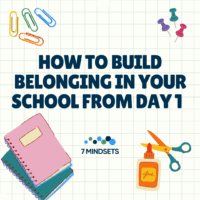Starting a new school year is more than just opening the doors to classrooms. It’s about creating an environment where every student, staff member, and family feels seen, valued, and connected. In a recent webinar, former principal Tracey Smith shared powerful strategies for weaving belonging into the fabric of school culture from the very first day.
Belonging as the Foundation of School Culture
Belonging is not simply a program or a checklist item. It is a feeling—the sense that you are accepted, respected, and free to be your authentic self. And when adults in a school community feel this way, it sets the stage for students to thrive in the same environment. Teachers and staff who feel connected and valued are better able to pass that sense of belonging on to students and their families.
Schools should be “a happy place” where people instantly feel connected upon entering. Often, schools provide not only academic support but also the safest and calmest spaces in children’s and adults’ lives. Cultivating this environment must be intentional from day one.
Four Pathways on How to Build Belonging
These four key practices can help bring belonging to life in schools:
 Dream Big – Live out your mission statement and values in tangible, visible ways. Schools can use mottos, murals, or simple hallway messages to reinforce positivity and purpose. Turn your mission statements like “be the Light” or “make today ridiculously amazing” into actions that remind staff and students of the shared values in the school. Dreaming big also means creating opportunities for connection—whether through celebratory open houses, playful staff traditions, or turning everyday activities like car line into moments of joy.
Dream Big – Live out your mission statement and values in tangible, visible ways. Schools can use mottos, murals, or simple hallway messages to reinforce positivity and purpose. Turn your mission statements like “be the Light” or “make today ridiculously amazing” into actions that remind staff and students of the shared values in the school. Dreaming big also means creating opportunities for connection—whether through celebratory open houses, playful staff traditions, or turning everyday activities like car line into moments of joy.- Embrace Creativity – Creativity fosters authentic expression and engagement. Schools can invite families, staff, and students to share their hopes for the year on communal walls, build “kindness trees,” or host unplugged family nights to encourage connection outside of screens. Even playful ideas, like mindset-themed superheroes who make surprise appearances at pep rallies, can spark joy and deepen cultural bonds.
- Think Positive – Positivity is not about ignoring challenges; it’s about reframing them in ways that allow people to feel safe enough to try again. Practicing gratitude is a transformative tool. Activities like “Fill the Plate,” where staff anonymously write affirmations for one another, or the whimsical “Cart of Awesome,” where administrators celebrate teachers with small gifts in front of students, remind both adults and children that they are valued.
- Act and Adjust – Belonging grows when leaders and teachers show flexibility and initiative. Challenges like car lines or noisy cafeterias can be reimagined with creativity—whether through morning kindness contests or turning lunch into a “fancy dining experience” as a reward. Modeling adaptability during crises, like serving lunch when the cafeteria staff is out sick or managing unexpected emergencies with positivity, also shows students and staff that community spirit can transform even the toughest situations.
Intentionality and Flexibility
The thread running through all of these strategies is intentionality. Belonging doesn’t happen by accident—it requires planning and consistent practices. But equally important is flexibility: the ability to adapt in the moment, turn obstacles into opportunities, and embrace unexpected joy. Consider this approach: planning the entire year with detailed calendar invites while also leaving room for spontaneous moments, like bringing in donuts when morale was low or chalking welcome messages on sidewalks before the first day. This balance of structure and creativity helps to continuously build belonging throughout the year.
A Call to Action
Consider this simple but powerful question: What is the one thing you will do this week to support belonging in your school?
Whether it’s reimagining a faculty meeting as a space for connection, asking students about their hopes for the year, or creating small rituals of gratitude, every action contributes to a welcoming culture. Belonging isn’t created by programs—it’s built by people who are willing to dream big, embrace creativity, think positively, and act with flexibility.
“Do all the good you can, in all the ways you can, to all the people you can, as long as you ever can.” –John Wesley

To learn more about building a belonging in your school, view the webinar, Building Belonging from Day 1: How Meaningful Connections & a Welcoming Culture Can Start the School Year Off Strong, presented by Tracey Smith.



